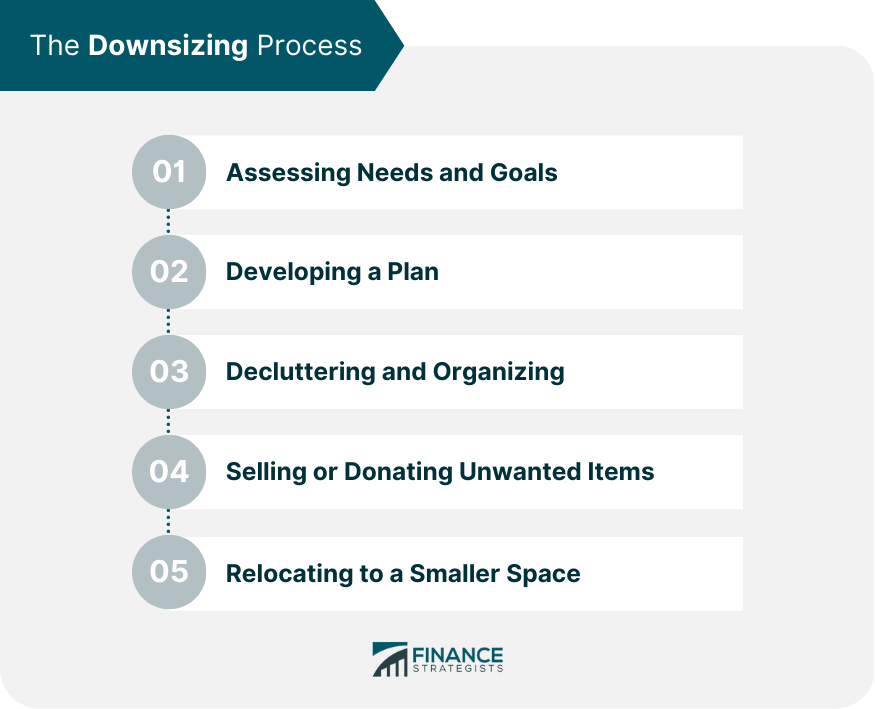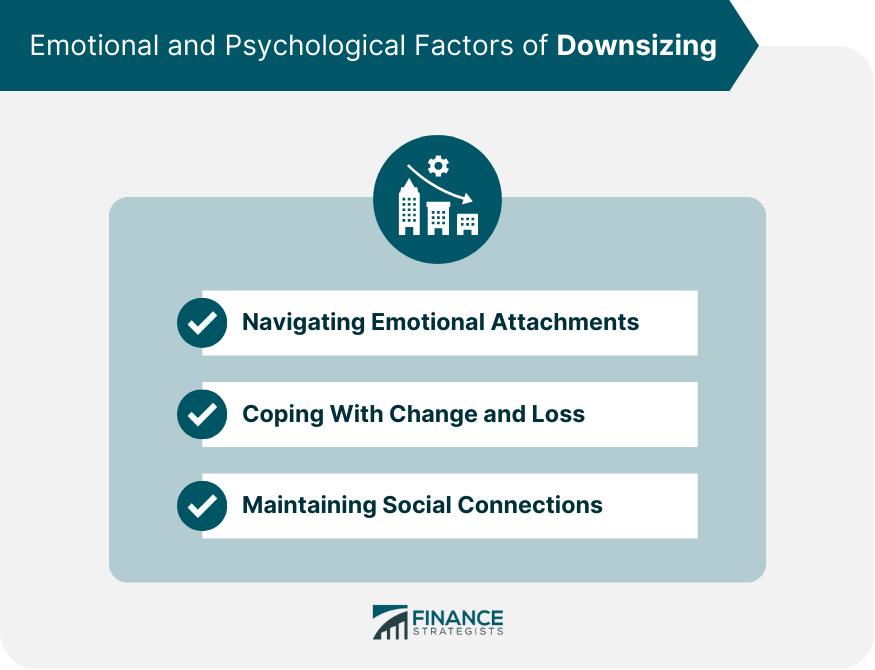Downsizing refers to the process of reducing the size of one's living space, personal possessions, or financial commitments. It typically involves simplifying one's life, decluttering, and making more efficient use of available resources. There are several reasons why individuals or families might choose to downsize, including financial reasons, lifestyle changes, or environmental concerns. Downsizing can offer numerous benefits, such as cost reduction, more manageable finances, and a simpler lifestyle. However, it can also present challenges, such as adjusting to smaller living spaces and navigating emotional attachments to possessions. One primary reason for downsizing is cost reduction. Living in a smaller space or reducing the number of possessions can lower housing costs, utility bills, and maintenance expenses. Downsizing can also help individuals better manage debt by reducing expenses and freeing up resources to pay off existing liabilities. For some people, downsizing is a way to simplify their financial lives, making it easier to track expenses and manage budgets. Retirement is a common reason for downsizing, as individuals may no longer need large homes or want to reduce expenses to make their retirement savings last longer. When children leave home, parents may find themselves with more space than they need. Downsizing to a smaller home can be a practical solution. Health issues or mobility challenges may prompt individuals to downsize to a more manageable living environment, such as a single-story home or assisted living facility. Downsizing can help individuals reduce their carbon footprint by consuming less energy and resources. Some individuals choose to downsize as part of a commitment to sustainable living and environmental stewardship. Others may be drawn to the minimalist lifestyle, which emphasizes living with fewer possessions and focusing on experiences rather than material goods. This involves evaluating current possessions and determining what is necessary and what can be eliminated. One should consider lifestyle changes and future needs when assessing their possessions and goals. Create a plan for downsizing that outlines the steps you'll take to declutter, sell or donate unwanted items, and relocate to a smaller space. It involves setting realistic goals and timelines for the downsizing process. This plan should include a budget for any necessary expenses, such as moving costs or storage unit rental fees. Decluttering and organizing is the actual process of downsizing, which involves sorting through possessions and deciding what to keep, sell, donate, or discard. This step can be emotionally challenging, especially when parting with sentimental items, but it is essential for achieving a clutter-free living space. Selling or donating unwanted items is a great way to downsize while also generating some extra income or helping others in need. Items can be sold through online marketplaces or at a yard sale, while donations can be made to local charities or non-profit organizations. This may involve moving to a smaller apartment or downsizing to a tiny house or RV. Regardless of the new living space, it is essential to make sure it fits one's needs and lifestyle. Downsizing can result in significant cost savings by reducing housing expenses, utility bills, and maintenance costs. There may be tax implications associated with downsizing, particularly if you sell your home or make substantial changes to your investment portfolio. Consult with a tax professional to understand any potential consequences. When relocating to a smaller home, consider factors such as location, accessibility, and potential resale value. It may also be helpful to work with a real estate agent who specializes in downsizing. Downsizing can have implications for your investment strategies and retirement planning. Review your financial goals and adjust your plans as necessary to ensure that downsizing aligns with your long-term objectives. Downsizing often involves parting with cherished possessions that hold sentimental value. It's essential to acknowledge and navigate these emotional attachments while making practical decisions about what to keep and what to let go of. Change can be challenging, and downsizing may bring feelings of loss or grief. It's crucial to give yourself time to adjust and seek support from friends, family, or professional counselors if needed. Downsizing may impact your social connections, particularly if you move to a new location. Make an effort to maintain existing relationships and build new ones in your new community. One of the most significant challenges of downsizing is adjusting to a smaller living space. To make the most of limited square footage, consider space-saving furniture, creative storage solutions, and multi-functional rooms. Adapting to a smaller living environment may require changing habits and routines. Be patient with yourself and your family members as you adjust to your new surroundings. As you downsize, you'll need to strike a balance between functionality and aesthetics. Focus on creating a comfortable, functional space that reflects your personal style and values. Careful planning and execution are critical to the success of any downsizing effort. By taking the time to assess your needs and goals, develop a plan, and navigate the emotional aspects of the process, you can make downsizing a positive and transformative experience. Change is an inevitable part of life, and downsizing presents an opportunity to embrace adaptation and growth. By focusing on the benefits and opportunities that come with simplifying your life, you can create a more fulfilling and sustainable lifestyle. Ultimately, the potential rewards of downsizing are substantial, ranging from financial stability to a greater sense of freedom and fulfillment. With thoughtful planning and execution, downsizing can be a powerful tool for creating a more balanced and intentional life.What Is Downsizing?
Reasons for Downsizing
Financial Reasons
Cost Reduction
Debt Management
Simplifying Finances
Lifestyle Changes
Retirement
Empty Nesters
Health Considerations
Environmental Concerns
Reducing Carbon Footprint
Sustainable Living
Minimalism
The Downsizing Process
Assessing Needs and Goals
Developing a Plan
Decluttering and Organizing
Selling or Donating Unwanted Items
Relocating to a Smaller Space

Financial Aspects of Downsizing
Savings and Cost Reduction
Tax Implications
Real Estate Considerations
Investment Strategies and Retirement Planning
Emotional and Psychological Factors
Navigating Emotional Attachments
Coping With Change and Loss
Maintaining Social Connections

Potential Challenges and Solutions
Space Limitations
Adjusting to a Smaller Living Environment
Balancing Functionality and Aesthetics
Conclusion
The Importance of Careful Planning and Execution
Embracing Change and Adaptation
The Potential Rewards of Downsizing
Downsizing FAQs
Downsizing refers to the process of reducing the size of one's living space, personal possessions, or financial commitments, typically with the aim of simplifying one's life, reducing expenses, or adapting to changing life circumstances.
People may choose to downsize for various reasons, including financial reasons (e.g., cost reduction, debt management), lifestyle changes (e.g., retirement, empty nesters, health considerations), or environmental concerns (e.g., reducing carbon footprint, sustainable living, minimalism).
Start by assessing your needs and goals, determining what you want to achieve through downsizing. Develop a plan outlining the steps you'll take to declutter, sell or donate unwanted items, and relocate to a smaller space. Then, begin the process of decluttering and organizing your possessions, deciding what to keep and what to let go of.
While downsizing can offer numerous benefits, it can also present challenges. Adjusting to a smaller living space, navigating emotional attachments to possessions, and maintaining social connections may be difficult. However, with careful planning and execution, many of these challenges can be successfully managed.
Focus on creating a comfortable and functional living environment that reflects your personal values and style. Embrace the benefits of a simplified lifestyle and prioritize your needs over your wants. Additionally, stay connected with friends and family, and engage in activities that contribute to your well-being and overall happiness.
True Tamplin is a published author, public speaker, CEO of UpDigital, and founder of Finance Strategists.
True is a Certified Educator in Personal Finance (CEPF®), author of The Handy Financial Ratios Guide, a member of the Society for Advancing Business Editing and Writing, contributes to his financial education site, Finance Strategists, and has spoken to various financial communities such as the CFA Institute, as well as university students like his Alma mater, Biola University, where he received a bachelor of science in business and data analytics.
To learn more about True, visit his personal website or view his author profiles on Amazon, Nasdaq and Forbes.











